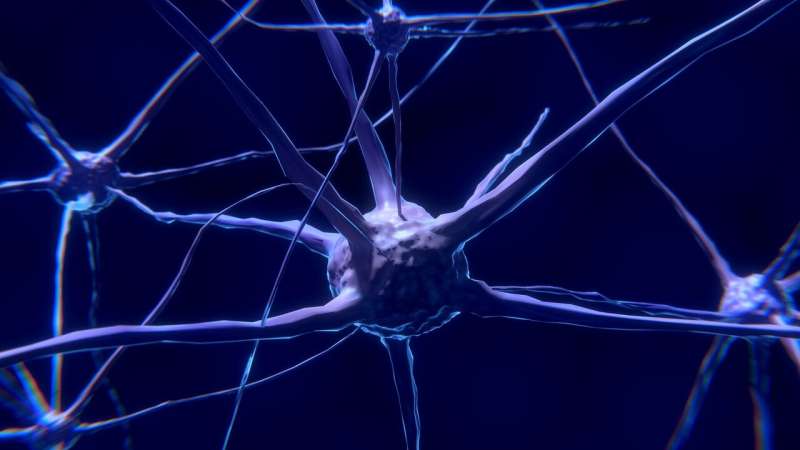This article has been reviewed according to Science X's editorial process and policies. Editors have highlighted the following attributes while ensuring the content's credibility:
fact-checked
peer-reviewed publication
trusted source
proofread
Study reveals function of little-understood synapse in the brain

New research from Oregon Health & Science University for the first time reveals the function of a little-understood junction between cells in the brain that could have important treatment implications for conditions ranging from multiple sclerosis to Alzheimer's disease, to a type of brain cancer known as glioma.
The study is published in Nature Neuroscience.
Neuroscientists focused on the junction, or synapse, connecting neurons to a non-neuronal cell, known as oligodendrocyte precursor cells, or OPCs. OPCs can differentiate into oligodendrocytes, which produce a sheath around nerves known as myelin. Myelin is the protective sheath covering each nerve cell's axon—the threadlike portion of a cell that transmits electrical signals between cells.
The study found that these synapses play a pivotal role in producing that myelin.
"This is the first investigation of these synapses in live tissue," said senior author Kelly Monk, Ph.D., professor and co-director of the Vollum Institute at OHSU. "This gives an understanding of the basic, fundamental properties of how these cells work in normal development. In the future, we might look at how they function differently in the context of MS patients."
The fact that these synapses exist at all was the subject of a landmark discovery by OHSU researchers at the Vollum that was published in the journal Nature in May 2000. Until that point, synapses in the brain had been known only to carry neurotransmitters between neurons, so the discovery of a synapse between neurons and OPCs came as a revelation.
"After two decades, we still didn't know what these synapses do," Monk said.
Scientists tackled the problem by using single-cell imaging of live tissue in zebrafish, whose transparent bodies enable researchers to see the inner workings of their central nervous system in real time. Using powerful new tools in imaging, pharmacology and gene editing, researchers were able to use neuron-OPC synapses to predict the timing and location of the formation of myelin.
The findings are likely the tip of the iceberg in terms of understanding the importance of these synapses, said lead author Jiaxing Li, Ph.D., a postdoctoral fellow in Monk's lab.
Oligodendrocyte precursor cells comprise about 5% of all cells in the brain—meaning the synapses they form with neurons could be relevant to many disease conditions, including the formation of cancerous tumors.
Li noted that previous studies have suggested a role for OPCs in a range of neurodegenerative conditions, including demyelinating disorders such as MS, neurodegenerative diseases such as Alzheimer's and even psychiatric disorders like schizophrenia.
By demonstrating the basic function of the synapse between neurons and OPCs, Li said the study may lead to new methods of regulating OPC function to alter disease progression. For example, these synapses could be the key to promoting remyelination in conditions such MS, where myelin has been degraded. In MS, this degradation can slow or block electric signals required for people to see, move their muscles, feel sensations and think.
"There may be a way to intervene so that you can increase the myelin sheath," he said.
Monk said the discovery may be most immediately relevant to cancer.
"In glioma, these synapses are hijacked to drive tumor progression," she said. "It may be possible to modulate the synaptic input involved in tumor formation, while still allowing for normal synaptic signaling."
Even though these precursor cells comprise roughly 5% of all human brain cells, only a fraction go on to form oligodendrocytes.
"It's becoming pretty clear that these OPCs have other functions aside from forming oligodendrocytes," Monk said. "From an evolutionary perspective, it doesn't make sense to have so many of these precursor cells in your brain if they're not doing something."
Their synaptic connection to neurons therefore likely plays a fundamental role in the brain, and is worthy of future exploration, she said.
In addition to Monk and Li, co-authors include Tania Miramontes of OHSU and Tim Czopka, Ph.D., of the Centre for Clinical Brain Sciences at the University of Edinburgh in the U.K.
More information: Synaptic input and Ca2+ activity in zebrafish oligodendrocyte precursor cells contribute to myelin sheath formation, Nature Neuroscience (2024). DOI: 10.1038/s41593-023-01553-8. www.nature.com/articles/s41593-023-01553-8





















